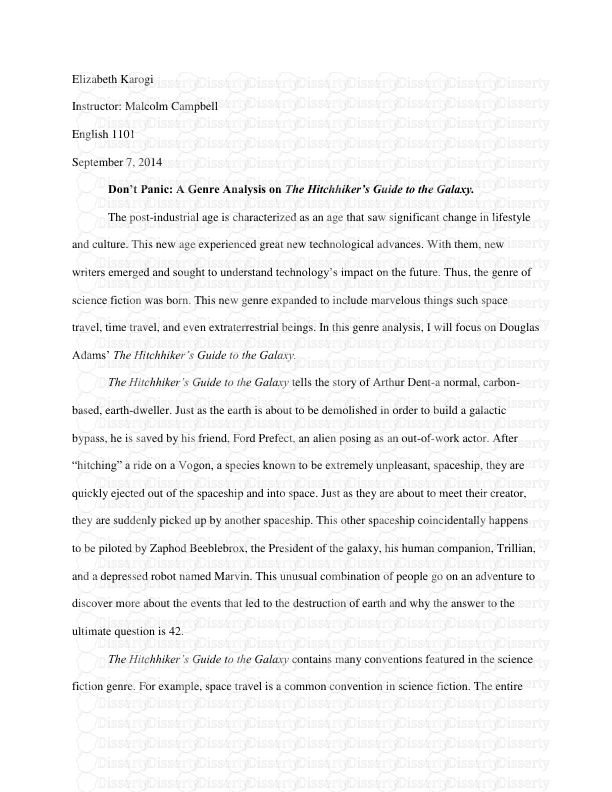Elizabeth Karogi Instructor: Malcolm Campbell English 1101 September 7, 2014 Do
Elizabeth Karogi Instructor: Malcolm Campbell English 1101 September 7, 2014 Don’t Panic: A Genre Analysis on The Hitchhiker’s Guide to the Galaxy. The post-industrial age is characterized as an age that saw significant change in lifestyle and culture. This new age experienced great new technological advances. With them, new writers emerged and sought to understand technology’s impact on the future. Thus, the genre of science fiction was born. This new genre expanded to include marvelous things such space travel, time travel, and even extraterrestrial beings. In this genre analysis, I will focus on Douglas Adams’ The Hitchhiker’s Guide to the Galaxy. The Hitchhiker’s Guide to the Galaxy tells the story of Arthur Dent-a normal, carbon- based, earth-dweller. Just as the earth is about to be demolished in order to build a galactic bypass, he is saved by his friend, Ford Prefect, an alien posing as an out-of-work actor. After “hitching” a ride on a Vogon, a species known to be extremely unpleasant, spaceship, they are quickly ejected out of the spaceship and into space. Just as they are about to meet their creator, they are suddenly picked up by another spaceship. This other spaceship coincidentally happens to be piloted by Zaphod Beeblebrox, the President of the galaxy, his human companion, Trillian, and a depressed robot named Marvin. This unusual combination of people go on an adventure to discover more about the events that led to the destruction of earth and why the answer to the ultimate question is 42. The Hitchhiker’s Guide to the Galaxy contains many conventions featured in the science fiction genre. For example, space travel is a common convention in science fiction. The entire novel follow Arthur Dent and company as they make their way through the cold and enormous space and to the planets of Damogram and Magrathea. Carl Sagan’s Contact can be compared to The Hitchhiker’s Guide to the Galaxy. The story follow Eleanor Arroway, a radio telescope astrophysicist who is working on the search for extraterrestrial beings. After years of pointing a telescope to various parts of the sky only to be met with silence, she finally hears a noise. This noise just so happens to be a blueprint from intelligent aliens instructing humans how to build a spaceship. Eleonor and other people then proceed travel to meet with the species that contacted them. The two novels involve space travel. Another convention included in The Hitchhiker’s Guide to the Galaxy is aliens. Adams’ includes many alien species in his novel. For example, there is Ford Prefect, the alien originating from Betelgeuse, and his two-headed cousin Zaphod Beeblebrox. Then there are the repulsive Vogons. Arthur and Trillian can also be considered alien- depending on the perspective. In Contact, Carl Sagan also included extraterrestrials. The only thing different from The Hitchhiker’s Guide to the Galaxy is that the alien are enigmatic to both the reader and the characters in the book. Advanced technology is alsco included in The Hitchhiker’s Guide to the Galaxy. The Heart of Gold, the spaceship that the team travels with, is described as being the most remarkable ship in the whole universe. Marvin, the depressed robot, is also referred to as a technological marvel. In Contact, the spaceship is made according to the directions sent by the mysterious aliens. Both spaceships are extraordinary in their respective universes. A constraint of a science fiction novel would be the lack of a threatening situation. Not many science fiction novels take place in a pleasant, conflict-free universe. Another constraint would be a conflict that is not solved by the protagonist. A pathetic and unheroic Arthur Dent was, he still came through and saved himself and his companions. The purpose of science fiction is to explore the “what if” situations in life. Adams questions what would happen if the planet earth was destroyed. Sagan talked about how he imagines communication between humans and aliens would go. Another purpose of science fiction is to entertain. Adams fulfils this well by his use of humor in his book which in turn keeps the reader captivated. The The Hitchhiker’s Guide to the Galaxy was developed in the 1970s. At this time, technology was at its peak. Space exploration such as lunar landings were happening and space stations and satellites were being launched into space. As one of the primary purposes of a science fiction novel is to entertain, The Hitchhiker’s Guide to the Galaxy would work well as a graphic novel. A graphic novel would help the audience get a better image of what is happening in the story. The general target audience of science fiction novels is people who enjoy reading speculative fiction. A graphic novel would attract those who might enjoy speculative fiction but not reading. An adoption into a graphic novel would include more readers into science fiction. uploads/Litterature/ genre-analysis.pdf
Documents similaires










-
60
-
0
-
0
Licence et utilisation
Gratuit pour un usage personnel Attribution requise- Détails
- Publié le Oct 12, 2022
- Catégorie Literature / Litté...
- Langue French
- Taille du fichier 0.2085MB


